Are Blue Cardinals Real Birds? Discover the Secret
Updated: 18 Apr 2024
30

Blue cardinals are mythical birds that have held people’s attention for centuries. Many people worldwide claim that they see blue cardinals, but until now, there has been no scientific evidence to prove they are real.
So, the question is, why do people claim they have seen blue cardinal birds?
In this article, we will discuss the blue cardinal in detail. We will cover the history of this enigmatic bird and why people claim to have seen blue cardinals, and we will also take a look at the scientific evidence that tells us blue cardinals are only a myth.
We will also give some tips about identifying this bird if you are fortunate enough to see one.
History of Blue Cardinal Sightings:

It is based on centuries of people reporting sightings of blue cardinals. The first recorded sighting dates back to 1722 when a Swedish naturalist named Pehr Kalm reported seeing a blue cardinal in North America.
Since then, people from around the world have claimed to spot blue cardinals. There are even websites dedicated to collecting and documenting these sightings.
However, it’s essential to note that there is no scientific evidence supporting the existence of blue cardinals. All reported sightings may result from misidentification or optical illusions.
Why Do People Think They Have Seen Blue Cardinals?

These are some reasons why people think they have seen blue Cardinals:
- Mistaken identity: Many birds have blue coloration, leading people to mistakenly identify them as blue cardinals in specific lighting conditions. Some of these blue birds include blue jays, blue grosbeaks, and indigo buntings.
- Pareidolia: Pareidolia is a phenomenon where the brain sees things that aren’t real. For example, you might look at a cloud and think it looks like a cat or a dog, even though it’s just a cloud. This happens when some people’s brains make them think they’ve seen a blue cardinal, even though it’s not real.
- Wishful thinking: Many people want to see blue cardinals because of the hype and popularity of this bird among bird lovers. Due to this wishful thinking, they might misinterpret what they’ve seen as a blue cardinal.
What Have You Observed Instead of Blue Cardinals?
People may observe the following birds instead of blue cardinals:
Blue Jay (Cyanocitta)
Blue jays are birds that people commonly observe and recognize due to their vibrant blue plumage. They are relatively large birds, featuring bright blue feathers, white underparts, and a distinctive black crest. These birds are frequently spotted in backyards and parks, where they are most notable for their loud and raucous calls.
Blue Grosbeak (Passerina caerulea)
Blue grosbeaks, often mistaken for blue cardinals, are also members of the cardinal family Cardinalidae. These medium-sized North American birds sport a blue-gray color with a reddish-brown chest. They are primarily found in open areas such as fields and meadows and are renowned for their charming medley of songs.
Indigo Bunting (Passerina cyanea)
Another bird species that people sometimes mistake for blue cardinals is the Indigo Bunting. These small, seed-eating birds are characterized by their vibrant blue plumage and small, black wings. They also sport a triangular crown on their heads and a rounded, plump body, which may be reminiscent of cardinals. Indigo buntings are renowned for their striking blue feathers and their beautiful warbling songs.
Tufted Titmouse (Baeolophus bicolor)
The tufted titmouse is a small bird with gray feathers, which some people may mistake for blue. Its white chest and black cap on the head can also lead people to confuse the tufted titmouse with a cardinal. This charming little bird is commonly found in woodlands and backyards and is renowned for its cheerful songs and acrobatic behavior.
Desert Cardinal (Pyrrhuloxia)
Desert cardinals are medium-sized birds that are sometimes mistaken for blue cardinals due to their gray plumage, which may appear bluish to some observers. The male desert cardinal features a crisp gray appearance with a red face and several other red markings, while the female is buffy gray with fewer red elements compared to the male.
These birds are primarily found in desert environments and arid scrublands, where they are renowned for their beautiful songs and their territorial behavior, often displaying aggression towards other cardinals.
Stellar’s Jay (Cyanocitta stelleri)
The Steller’s Jay is a beautiful bird that is sometimes mistaken for blue cardinals. They are large, blue-black birds with white breast and a long black crest. These birds are usually found in western North America and the mountains of Central America. They are somewhat related to the blue jay and are mostly seen in coniferous forests. Steller’s Jays are known for their loud, raucous calls and their intelligence.
Florida Scrub Jay (Aphelocoma coerulescens)
The Florida scrub jay is often mistaken for a blue cardinal, despite lacking any crowns on their head. These medium-sized birds exhibit a blue-gray hue on their bodies, accompanied by a white chest and brow.
Typically found in Florida scrublands, they share similarities in body structure with blue cardinals but are notably smaller and possess long, thin beaks. Renowned for their cooperative behavior, Florida scrub jays are also known to mimic the voices of other birds.
Northern Cardinals in Certain Lighting Conditions:
The final birds are Northern Cardinals that people often perceive as blue cardinals. These medium-sized, red birds have a black crest and mask, commonly spotted in backyards and woodlands. Renowned for their melodious songs and territorial behavior, Northern Cardinals are a familiar sight.
Under specific lighting conditions, such as dawn or dusk, Northern Cardinals may appear somewhat blue. This bluish hue results from the interaction of their feathers with the ambient light, as the red feathers absorb more light than the blue ones.
Scientific Proof Suggests Blue Cardinals Are Not Real:
While many people believe in the existence of blue-colored cardinals, the harsh reality is that all scientific evidence tells us that this enchanting bird is not real. Here are some reasons why:
- No Presence in Official Bird Lists: Blue cardinals are not recognized as legitimate species by ornithological organizations such as the American Ornithological Union (AOU) or the Cornell Lab of Ornithology. These organizations compile bird lists based on scientific data, and none include any type of blue cardinal.
- Lack of Genetic Evidence: Despite advancements in genetics, no genetic evidence of blue cardinals has been found. Genetic evidence is crucial for identifying new species, but the absence of any genetic markers suggests that the blue cardinal has no biological reality.
- Inconsistent Sightings: Reported sightings of blue cardinals are highly inconsistent, with observers unable to provide clear descriptions. This inconsistency leads to misidentifications and may be attributed to optical illusions or sightings of other birds.
- Look-Alike Birds: Several bird species, such as blue jays, indigo buntings, and blue grosbeaks, bear a resemblance to blue cardinals with their vibrant blue plumage. These look-alike birds can easily be mistaken for blue cardinals, especially under low light conditions or from a distance.
- Lack of Observed Breeding Pairs or Populations: There have been no documented instances of blue cardinals forming breeding pairs or establishing populations. The absence of breeding behaviors is significant in considering the existence of a species.
- Absence of Fossils or Historical Records: Despite extensive scientific research, no fossils or historical records of blue cardinals have been discovered. The lack of evidence spanning centuries further supports the conclusion that blue cardinals do not exist.
Conclusion:
In conclusion, the topic of the blue cardinal has been an intriguing mystery among people for centuries. Many have reported sightings and claimed to have seen the blue cardinal, but they haven’t provided clear descriptions. Often, they mistake other birds that resemble blue cardinals, such as the blue jay, blue grosbeak, and indigo bunting. Despite numerous sightings, there is no scientific evidence confirming the existence of this bird, indicating that it is not a real species. Additionally, ornithological organizations do not recognize the blue cardinal as a legitimate species due to inconsistent sightings, lack of genetic evidence, and absence of fossil or historical records.
Ultimately, our interest in blue cardinals reflects our curiosity and fascination with nature and its mythical tales. However, scientists advise us to rely on factual evidence and not believe in myths. Thus, the blue cardinal remains a whimsical story in our imagination that keeps our love for birds alive.
FAQs:
Is the blue cardinal real?
No scientific evidence supports the existence of this bird. People who claim to see it also cannot provide a clear-cut description. Therefore, the blue cardinal remains a myth. If you think you’ve seen this bird, you might be mistaking it for others that resemble it, such as the blue jay, blue grosbeak, or indigo bunting.
Where are blue cardinals found?
Blue cardinals are mythical birds and are not found in nature. There is no scientific evidence of this bird, and people who claim to see it often mistake other birds for blue cardinals.
How rare is a blue cardinal?
Blue cardinals are extremely rare because they are not real birds.
Please Write Your Comments